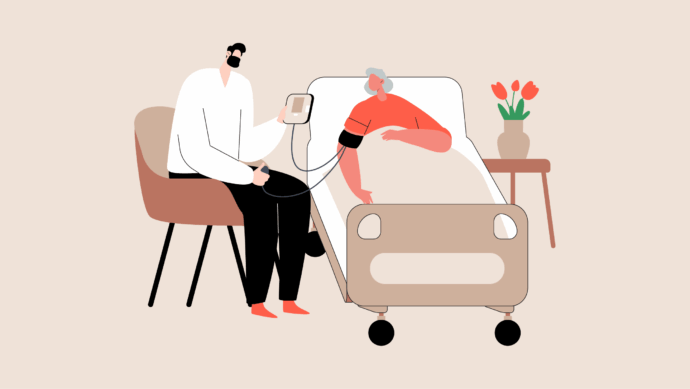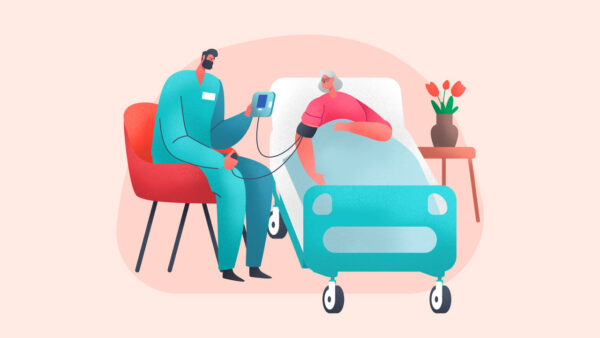
Despite healthcare becoming ever more technological and administratively driven, the humane component of medicine is critical to treatment and successful outcomes in the first place. It was found that 82% of Sermo poll respondents viewed bedside manner as crucial for building trust and a positive relationship with patients.
Bedside manner is all about emotional appeal and engagement. It’s something that machines simply cannot provide. Instead, as emotions are a natural component of humanity, they inspire a level of trust for doctors and patients alike, fostering better treatment, compliance, and efficacy for quality of life and improved health. According to an urologist from the USA, “We can truly make a positive impact on the lives of those we serve through compassion. A physician’s compassionate bedside manner can provide solace and comfort to a patient with a life-altering diagnosis. By showing empathy and understanding, healthcare providers can instill hope and foster a healing environment.”
This sentiment isn’t isolated to one medical specialty or one country. A paediatrician on Sermo notes, “Since the dawn of time, one tool doctors have always had access to is a bedside manner. Drugs come and go, technology improves, though the doctor-patient relationship remains sacrosanct.” However, 42% of surveyed physicians on Sermo report that the most challenging aspect of bedside manner is balancing empathy and medical efficiency.
A GP states, “Bedside manner is very important yet challenging, because it creates emotional bonding, trust, and mental treatment with the patient, while keeping the patient comfortable… We need a good technique for bedside manner because if it becomes excessive, it could lead to misperception and wasting a lot of time. We should also learn about the cultural habits or patients’ beliefs, and if needed, we could bring a nurse as a witness to avoid misperception that could lead to sexual harassment when touching a different gender of patients.”
Regardless of the challenges, doctors acknowledge the necessity of maintaining these key relationships. A Sermo poll suggests that 26% of respondents work to help ensure effective and positive bedside manner by being culturally aware and educated on traditions and beliefs relevant to the patient. This shows a level of emotional intelligence and empathy. A general practitioner in the USA states, “Throughout my career, I’ve made a conscious effort to listen actively and communicate with empathy at the bedside. I would tell other physicians that a strong bedside manner not only builds trust, but also significantly improves patient outcomes.”
What is bedside manner in healthcare?
Bedside manner refers to how practitioners convey treatment to a patient. It is both verbal and nonverbal communication (body language) coupled with empathic awareness and undivided attention, all to create a healing atmosphere. Someone trained with medical knowledge should not possess good bedside manner as an extra perk. It should be expected—when clinical knowledge is applied without a human element, it often lacks the proper treatment of a patient.
Quality bedside manner not only keeps patients satisfied, but it also turns it into quantitative data. An internal medicine physician notes that “Bedside etiquette is an indispensable soft skill in medical practice, with its significance extending beyond maintaining doctor-patient relationships to directly influencing treatment outcomes and patient experiences. Modern medical studies demonstrate that exemplary bedside etiquette can reduce the average length of hospital stays by 1.8 days, decrease hospital-acquired infection rates by 15%, and lower patient readmission rates by 22%. These statistics validate Hippocrates’ adage that “Medicine is both a science and an art,” emphasizing that etiquette standards are not mere formalities but essential clinical technical elements in the era of precision medicine. The data confirms how behavioral protocols in patient interactions constitute a crucial component of evidence-based medical practice, integrating humanistic care with scientific rigor to enhance healthcare quality systematically.”
“In interacting with my patients, I try to express and demonstrate a demeanor of compassion, listening ability, and an attitude to show attentiveness that is sincere coming from the heart, as well as provide quality time. This, I believe, will lead to optimum trust and improved diagnostic acumen and treatment,” explains another doctor on Sermo. This corresponds to Sermo members’ beliefs about managing patient anxiety, where 62% of the respondents said they take extra time to listen and reassure their patients.
11 examples of good bedside manners
1. Pay attention to the patient
Physicians are expected to be with a patient, and only with a patient, during consultations. They should not be on their phone, tablet, or completing admin tasks, unless they are documenting something medically related and only for that visit/appointment. Being distracted shows patients that the physician is not really paying attention to their case or to them as a person. “Bedside manner is essential! I do find that it’s sometimes hard to balance looking at the chart and checking all the EMR boxes (i.e, problem lists, follow-ups, prescriptions, refills, reviewing labs, etc) while maintaining eye contact. If I didn’t look at the chart and just maintained eye contact for most of the visit, I would spend hours and hours of charting after a long day of clinic. It’s a hard balance, but I try to strike that balance!,” explains an endocrinologist from the USA.
2. Don’t get into an argument
Patients can get frustrated with processes and sometimes have misconceptions. While it’s easy to fall into the trap of quarreling back, it’s not appropriate. Engage the patient, listen to their ideas and concerns, and consider their point without arguing with them.
3. Listen
There’s no better bedside manner than listening. An anesthesiologist on Sermo explains, “Good questioning, patient and attentive listening, more empathy, and good treatment are the keys to a good doctor-patient relationship, generating trust and often improving results.” In a recent poll on Sermo, 35% of physicians employed active listening to improve their bedside manner.
4. Be empathetic
Demonstrate a deep understanding of what a patient is feeling and fearing. Validate their emotions and respond accordingly, acknowledging that whatever situation brought them to your office at this moment may extend beyond what’s presenting itself. Poll results show that maintaining eye contact, using a calm tone of voice, and nodding to acknowledge understanding are 3 key non-verbal clues that doctors employ to show empathy.
5. Be detailed
Articulate diagnoses, treatments, and anticipated outcomes in a clear, yet patient-understandable fashion. According to a Sermo survey, 35% of physicians say it’s important to provide clear and jargon-free information about medical conditions and treatments. When patients are kept in the loop, they will become educated and vested in their treatment. “One thing I always do with patients is consider them as if they were family members. So…when I recommend a treatment, it is one that I would recommend for someone in my family. Sometimes, patients will ask me, if this were a family member, how would you treat him/her? My answer usually is, ‘given your condition, I would recommend the same treatment,'” explains a US dermatologist on Sermo.
6. Don’t judge
Never hold a patient’s lifestyle against them or make assumptions. Don’t imply disagreement with what they do, did, or how they may not have previously followed physician advice in the past. When patients trust that they will not be shamed, they’ll feel more comfortable divulging what’s wrong.
7. Ensure privacy
In addition to confidentiality and dignity, ensuring physical privacy, especially that appropriate examinations are done with the proper and expected privacy, will only enhance a therapeutic connection. It’s also important to ensure that personal information is kept private at all times, and that personally identifiable information is not shared outside of your interactions with the patient.
8. Stay vigilant
Pay attention to what isn’t being said through body language, discomfort, or potentially unresolved issues. Many times, what is observed is key information that the patient isn’t ready to disclose publicly or discuss just yet. Posture, gestures, and positioning all speak as much as a person may verbally communicate.
This also holds true of your own body language. Be aware of the non-verbal signals your own behavior may be communicating, including posture, facial expressions and fiddling.
9. Don’t dismiss complaints
Avoid downplaying what a patient comes in for as something that could be unimportant. Even if it seems unimportant in a trained mind, it could contribute to anxiety and stress for the patient. When it is downplayed, it’s akin to a lack of care and could even result in a misdiagnosis.
10. Be professional
Decency always will be relevant. Therefore, professionalism comes from not only the heart but also how one treats and presents oneself to others. A family medicine physician from the USA says, “Dress, body odor, and breath are also indispensable components to bedside manners.”
11. Ask more questions
Follow up with additional questions beyond what the patient initially discusses. This assesses the concern more thoroughly and identifies whether the patient has really understood what you’ve said. Demonstrate you care, and follow up when appropriate.
Why are bedside manners important?
Improves patient outcomes
Good bedside manner influences clinical outcomes. When patients feel they’ve been validated and heard, they are more likely to provide information that will help them and be more compliant with treatment and vested interests in their healing.
Decreases patient anxiety levels
A compassionate approach helps alleviate fears associated with illness and being in a clinical setting. Less anxious patients are in better healing environments, which may translate to faster recovery times.
Creates an overall better experience and increased patient satisfaction
“Bedside manner and empathy make for loyal patients who will refer their friends, coworkers, and family,” explains an OBGYN from the USA. This means greater satisfaction, which aids not only current experience but practice growth and reputation.
Fosters trust from the patient and assists with healing
“Good bedside manner can foster trust from the patient and reduce non-compliance or bad outcomes due to avoidance of medical care,” shares another physician on Sermo. When people have a good rapport established, it helps when a difficult diagnosis needs to be rendered, or extensive treatment plans need to be suggested.
Professional benefits for bedside manners that count
The professional benefits for the success of the physician’s practice are at stake, too. “Having a good rapport & bedside manners with patients & their relatives gets the best outcomes for all concerned. Inadvertent errors are not held against the medical professional & also fewer complaints for perceived slights,” reveals a general surgeon from the UK. A gastroenterologist in the USA agrees: “So many of my colleagues have no sense of bedside manner and don’t care that it severely impacts their doctor-patient relationship. Ultimately, this impacts the patient’s trust in them. In the long run, these physicians lose patients, are not effective in their practice, and are poorly rated in surveys. All it takes is a smile, a little extra time, maybe a joke or some kidding. You would be surprised how effective this can be in your practice.”
Join the discussion on Sermo
Sermo is an international physician community that empowers physicians to share their experiences and find real-world solutions to provide better care. Join the conversation with over 1 million other verified physicians who think similarly about what it means to provide quality patient care in an empathetic, communicative environment with strong interpersonal connections. Whether you’re seeking guidance on next steps or wanting to educate others with your knowledge, Sermo is the collaborative place for like-minded professionals to advance their experience of the art of medicine as much as the science.















